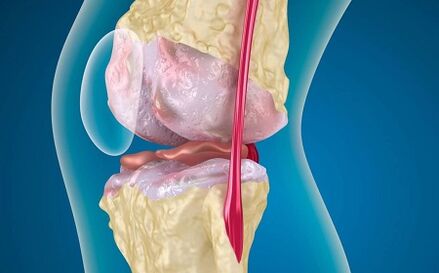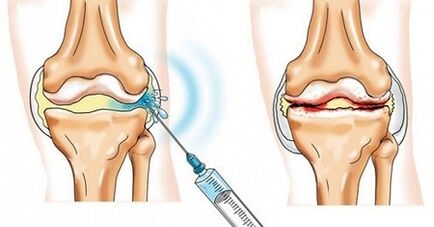
It will be about such an unpleasant disease of the musculoskeletal system as knee joint arthrosis.From the article, you can find out what type of disease is, why it occurs, what are the main symptoms of knee arthrosis and how to treat this insidious disease.
Knee articulation arthrosis (another name - gonarthrosis) is a chronic knee joint disease, which is called joint destruction of joint cartilage, followed by joint deformation and limiting motor activity.
Gonarthrosis is the most common type of arthrosis.Most of the time, the disease is diagnosed in people 40 or older.In the oldest age group, knee arthrosis is more common in women, among younger patients the disease is most often diagnosed in men.In approximately 7% of cases, the disease leads to the development of disability.
Reasons
The main causes of disease development are:
- Violation of metabolism in the body;
- overweight, which leads to an increase in knee joint load;
- Increased capillary fragility, various circulatory disorders;
- Knee joint injuries (cracks, fractures, meniscus ruptures, ligaments);
- Some endocrine diseases;
- inflammatory joint diseases (arthritis, rheumatism);
- old lesions that were cured incorrectly;
- Traumatic sports classes for knees (heavy athletics, bodybuilding, football, gymnastics, tennis, athletics);
- Hereditary predisposition;
- Congenital anomalies of the knee joint structure.
Types of arthrosis
The following types of arthrosis are distinguished by the origin:
- Primary- Most of the time, it occurs in the elderly, at risk, they are patients with obesity;
- secondary- It develops after knee injuries or infectious diseases that were cured incorrectly.
According to the location of the pathological process, the following types of knee arthrosis are distinguished:
- Left- affects the joint of the left knee, more often observed in athletes and patients with obesity average age;
- RIGHT -Out- affects the right knee articulation, is most often found in athletes and people whose work is associated with increasing dynamic and static loads in the right leg;
- bilateral- The most severe type of knee joint arthrosis, which can lead to disability, is most often found in older people.
Symptoms
The main clinical signs of the disease are:
- Knee pain - At first, pain occurs with increasing physical effort in the joint, movement, running, long walk and disappearing at rest as the disease develops, patients appear while trying to start moving after a long rest period, it is difficult to descend the ladder over time, knee pain becomes constant;
- Morning rigidity in the knee joint - lasts about half an hour, with time the duration can increase;
- crispy knee when moving;
- With the development of the inflammatory process, patients complain about the weight of weight in the knee, the joint is slightly swollen and increases the size;
- The shape of the joint gradually changes, its deformation occurs;
- With the additional development of the disease, lameness appears, knee joint movements are limited, the patient cannot completely print the painful leg;
- Atrophy of femoral muscles develop gradually, they become weak and flabby, diminish the volume.
Treatment
When the first unpleasant symptoms appear, you should immediately consult a doctor and undergo an exam.Opposite treatment will increase the chances of recovery and improve the prognosis.Self -duty is unacceptable and can lead to the development of various complications, even the disability!
The treatment of knee arthrosis includes the following stages.
NO -Drug Therapy
- The painful joint needs to ensure that rest, so that crutches or sticks are used to discharge it;
- Ultraviolet irradiation, heat - for pain removal;
- Wearing special orthopedic shoes, knee pads, special insoles;
- Massage, exercise therapy, physiotherapy - are prescribed after interrupting the acute stage of the disease.
Drug therapy

- Reception of NSAIDS inside (compresses) and externally (gels, ointments) - to relieve inflammation and knee pain;
- Special drug injections in the joint cavity - are performed in the absence of the effect of taking NSAIDs;
- Slow system systems - to normalize metabolic processes in cartilaginous tissue;
- Means to improve blood circulation - contribute to the normalization of blood circulation in pathological focus and improving drug delivery to the damage zone.
Surgical intervention
It is shown with a complete loss of joint function and includes knee joint prostheses.
Health for you and your loved ones!























